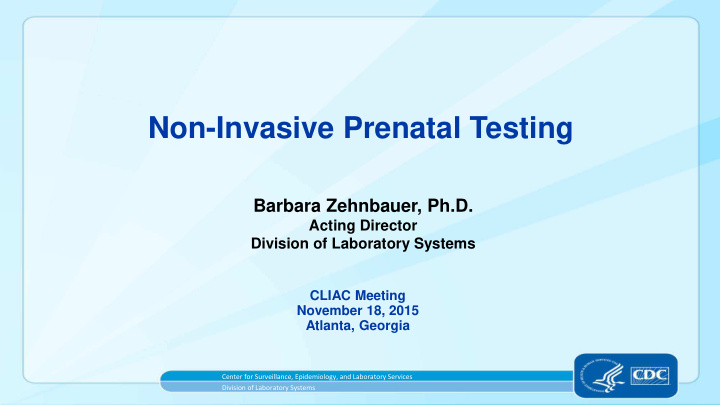



Non-Invasive Prenatal Testing Barbara Zehnbauer, Ph.D. Acting Director Division of Laboratory Systems CLIAC Meeting November 18, 2015 Atlanta, Georgia Center for Surveillance, Epidemiology, and Laboratory Services Division of Laboratory Systems
Prenatal testing Non-invasive – • Abdominal ultrasound (US) • Nuchal translucency US or nuchal fold scan • Triple or quadruple screening – hCG, AFP, estriol, Hormone inhibin A • Cell-free fetal DNA testing Invasive – • Chorionic villus sampling • Amniocentesis • Cordocentesis (PUBS)
Intended Uses High-risk pregnancy – diabetes, cancer, high blood pressure, > 35 yo, past problems in past pregnancy, infections, etc Screening Diagnosis
Non-Invasive Prenatal Testing (NIPT) Maternal peripheral blood sample Detects circulating, cell-free fetal DNA as early as 10 wks Screening for fetal aneuploidies with MPS (chr 21, 18, 13 trisomies) • Sequenom – MaterniT21 • Illumina – Verinata verify™ • Roche (Ariosa) – Harmony Prenatal Test ™ SNP-based tests – trisomies and fetal sex • Natera – Panorama™
Limitations of testing Initially validated for use in high-risk pregnancies As early as 10 weeks gestation Intended as screening tests Abnormal findings to be confirmed by diagnostic testing (amniocentesis or CVS) prior to decisions about whether to terminate a pregnancy Not appropriate for many known genetic abnormalities, ie normal NIPT does not rule out other genetic disorders
Concerns of Stakeholders Patients Physicians Laboratories Regulators Ethics, legal , & social issues
Noninvasive Examination of Trisomy (NEXT) study* Blinded prospective study compared Cell-free fetal DNA (cfDNA) testing - Ariosa’s Harmony test First trimester biochemical and nuchal translucency 15,841 pregnant women (at least 18 yo) at average risk for fetal abnormalities 35 centers in 6 countries The positive predictive values of cfDNA testing and standard screening for trisomy 21 were 80.9% and 3.4%, respectively. cfDNA testing had higher sensitivity and specificity.
Enrollment and Outcomes. Norton ME et al. N Engl J Med 2015;372:1589-1597
Possible solutions Education of stakeholders – genetic consultation pre-test and post-test Additional test validation requirements Clearer test labeling – • indications • limitations • interpretations • follow-up confirmatory testing
Questions for CLIAC What should labs performing NIPT disclose • Assay validation for different patient populations? (high-prevalence of genetic disorders vs general population) • Performance specifications for aneuploidy detection? • Regarding risk interpretation in result reporting? • About confirmatory diagnostic testing? How can laboratories help physicians and patients be better informed about the limitations and appropriate use of NIPT? Is there a role for FDA/CMS/CDC in providing that information?
Recommend
More recommend